Recent Articles
Popular Makes
Body Types
2017 Honda Accord Hybrid Road Test and Review
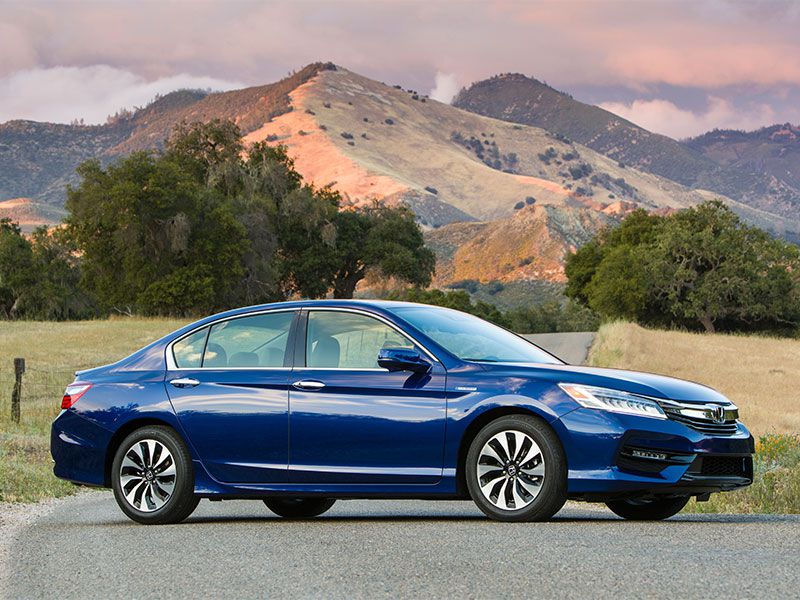
2017 Honda Accord Hybrid profile ・ Photo by Honda
When you buy the hybrid version of a sedan—as opposed to a dedicated hybrid like the Toyota Prius—you're essentially trading space for fuel economy. But as with any negotiation, you shouldn't be too quick to give away too much. With Honda’s freshly-updated 2017 Accord Hybrid, you get lots of space without giving away much fuel economy, and that, in our opinion, makes this hybrid sedan a very smart choice indeed.
A Brilliant Hybrid Drivetrain
For years, Honda's hybrids played second (if not third) fiddle to those from Toyota. Honda's original hybrid system, called Integrated Motor Assist (IMA), simply did not deliver the same stellar fuel economy as Toyota's Hybrid Synergy Drive. All that changed in 2014, when Honda introduced their new hybrid system, alternately called Earth Dreams or Intelligent Multi-Mode Drive (i-MMD) and known informally as the dual-motor hybrid.
Whatever you call it, Honda's latest hybrid system is brilliant. In typical Honda fashion, rather than adapt someone else's ideas, they've developed a unique system of their own, and the result is a hybrid sedan that delivers a smoother drive than its competitors—and, more importantly, superior fuel economy.
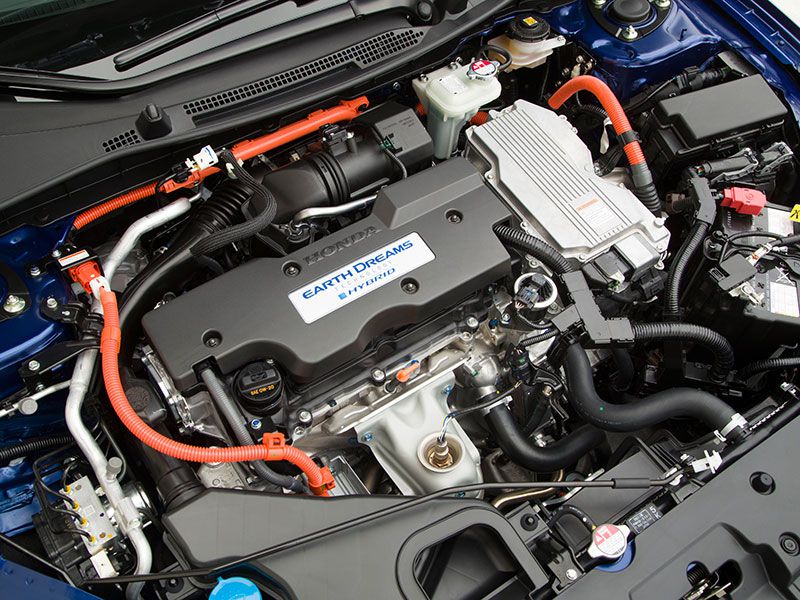
Photo by Honda
Why is Honda's hybrid different—and better?
Let's take just a moment to discuss what makes Honda's hybrid system different (and, in our opinion, better). Most hybrids have a gas engine, a battery-fed electric motor, and some sort of mechanical transmission that links them together. Toyota uses the gas engine and electric motors as inputs to the transmission; Hyundai/Kia (and Honda's old IMA system) sandwich a motor between the engine and transmission. What they have in common is that both power sources deliver power directly (i.e. via mechanical means) to the wheels.
Honda's i-MMD does things differently: In most situations, the gas engine’s only job is to turn a generator, while the wheels are driven by an electric motor. Power for this motor comes from the battery, the engine/generator, or a combination of both. With only the electric motor delivering power to the wheels—as opposed to a mechanical mix of gas and electric power—acceleration is smooth, strong and seamless, no matter whence the electricity cometh. The system poses a sharp contrast to the jerks and surges that accompany other hybrids, and it's such a brilliant idea that one has to wonder why it hasn't been thought of before.
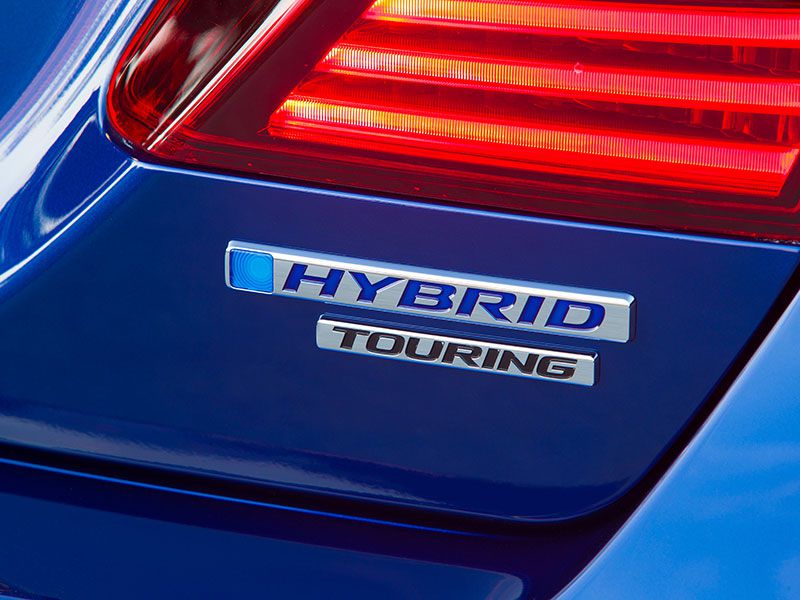
Photo by Honda
Fuel Economy: Best in Class
There is, by the way, one exception to the electric-drive-only rule: Honda figured out that at steady speeds of around 60 MPH, it's more fuel-efficient to let the gas engine drive the wheels directly. So under those conditions, the engine is connected directly to the drive wheels (actually to the motor that drives the wheels). When the car moves out of that speed envelope, the engine is disconnected and it's business as usual. (For the record, the Chevrolet Volt does something similar.) The clutching/de-clutching is completely seamless, and we never noticed it happening.
Thanks to a series of improvements for 2017—including smaller and lighter motors, electronics and battery that yield an improvement in total system power to 212 hp—the Accord Hybrid trounces the competition on EPA-rated fuel economy, with estimates of 49 MPG city, 47 MPG highway, and 48 MPG combined. Compare that to the EPA combined estimates for the Chevrolet Malibu hybrid (46 MPG), Ford Fusion hybrid (42 MPG), Hyundai Sonata hybrid (41 MPG), and Toyota Camry hybrid (40 MPG). Our test drive on the back roads near Napa, California, wasn't long enough to get a good real-world fuel economy figure, but we averaged an impressive 45 MPG in the old model, and we are confident that the new version will deliver real-world MPG at or close to its EPA combined figure.
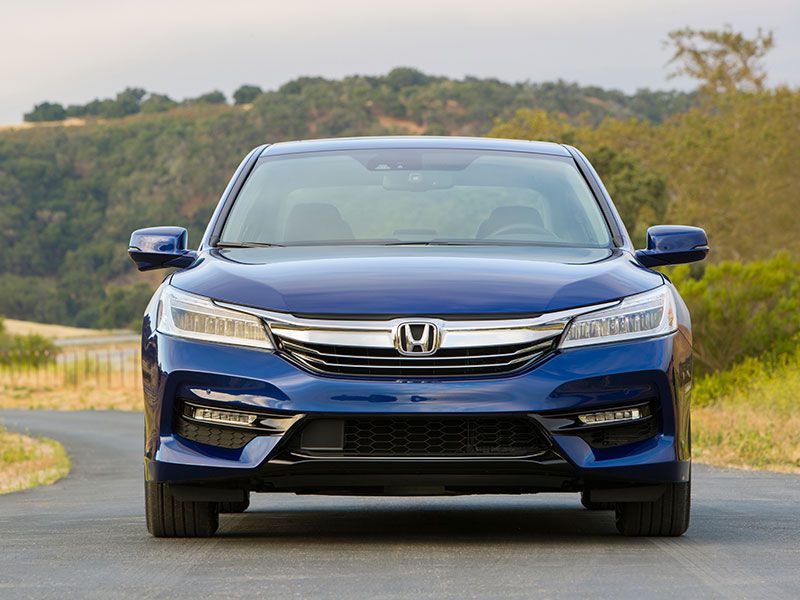
Photo by Honda
A Hybrid with Get-Up-and-Go
One thing our Napa test drive did give us a chance to try was the Accord Hybrid's passing power. We normally don't like to try quick passes in a 4-cylinder hybrid, but something about the Honda Accord told us it might be worth a try. So when we encountered a slow-moving Chevy, we decided to floor the pedal and see what happened. And what happened was impressive: The Accord's 2.0-liter engine instantly wound up to its maximum-torque speed and stayed there, while the computer called in maximum juice from the battery. The Accord Hybrid rapidly picked up another 20 MPH, giving us the speed we needed to get around the slow-moving sedan. It was a performance that belied the hybrid system's 212-horsepower rating (which, though not a very big number, is best in class). The passing maneuver didn't do much for our fuel economy, but it's good to know the Accord Hybrid can deliver the juice when you need it.
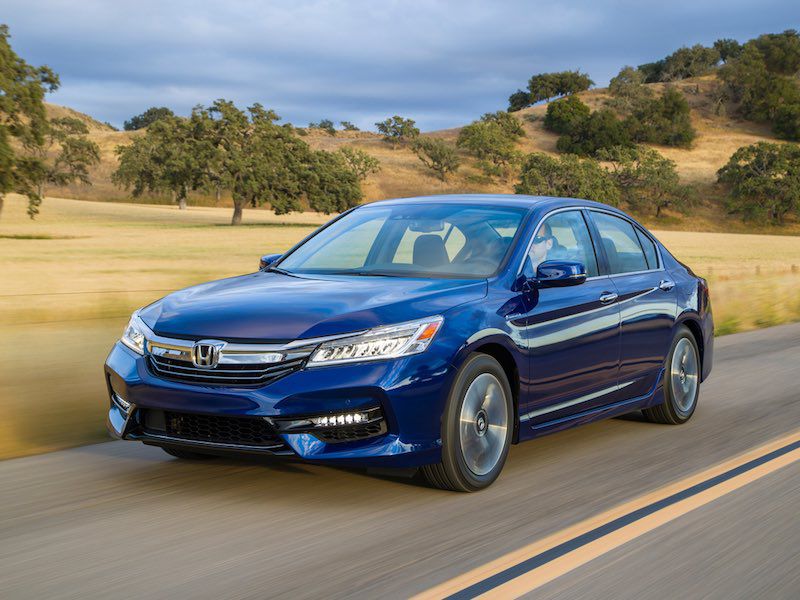
Photo by Honda
Updated Inside and Out—But Still No Volume Knob
Along with the upgraded hybrid system, Honda has made a number of changes to the Accord Hybrid for 2017, most of which echo the updates made to conventionally-powered Accords for the 2016 model year. The front and rear ends feature new styling with more chrome (blue-tinged on the hybrids, apparently, though we had trouble seeing the color). If we’re going to be honest—and why wouldn’t we?—the new styling does the Accord no favors; it looks a little over-adorned, like a person wearing too much makeup, especially on higher trim levels with LED headlights.
Inside, the center stack and shifter have been shuffled around to provide more storage space, and Honda now offers a wireless phone charging pad as a dealer-installed accessory (which we applaud—this is a fantastic feature, but there’s no sense paying for it if your phone doesn’t support it). We like the relative simplicity of the driving and climate controls, but we’re not fans of the 2-screen layout found in higher-trim Accord Hybrids. Honda has added Android Auto and Apple CarPlay compatibility to these models, but their display stereo still lacks a volume knob, featuring a touch-pad and steering-wheel buttons instead. (We're not the only ones who find this annoying; Honda tells us that the volume knob will return, but not this year.)
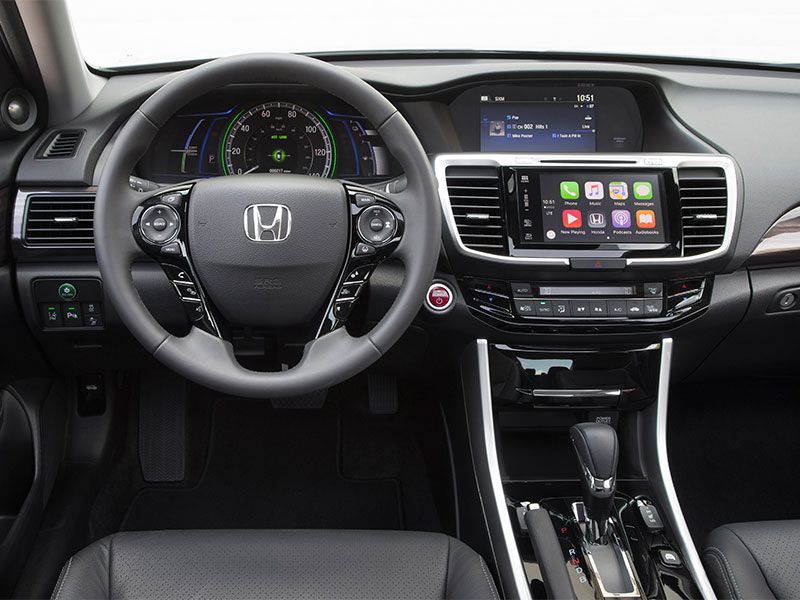
Photo by Honda
More space in the one place it's needed.
No changes have been made to the Accord’s back seat, and indeed none were needed—this is one of the roomier midsize sedans on the market. But the 2017 Accord Hybrid does get some much-needed trunk space thanks to the smaller hybrid battery. (One of the drawbacks of a hybrid sedan, as opposed to a dedicated hybrid, is that the battery usually eats up trunk space.) Trunk volume increases from 12.7 to 13.5 cubic feet, and while that may not sound like much, it’s enough to boost the Accord’s cargo space from “too small” to “just big enough.”
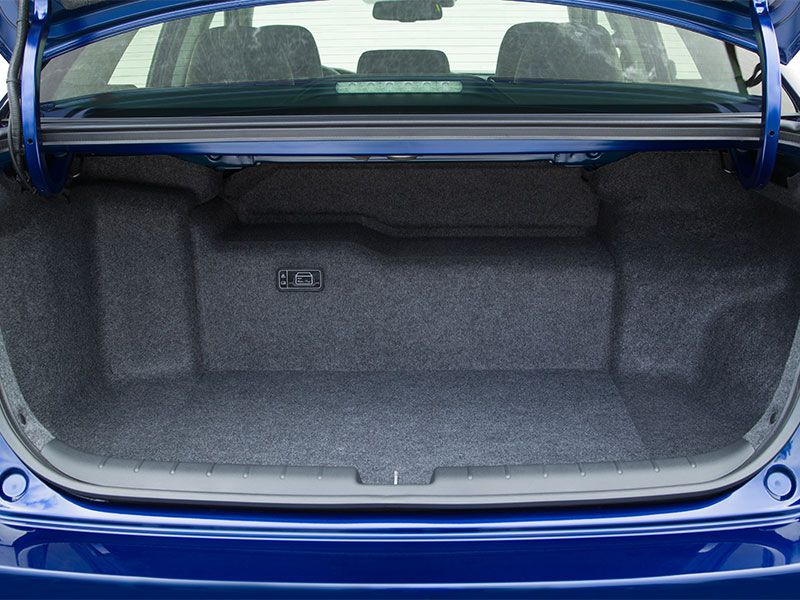
Photo by Honda
Accord owners might never need new brakes.
Along with the powertrain, Honda has made improvements to the chassis. All Accord Hybrids get a special type of shock absorber that can stiffen its response to bigger bumps, providing the Accord Hybrid with a smooth, soft ride that doesn’t disintegrate when the road turns choppy. Honda has also made updates to the steering system, and while the Accord Hybrid handles well, it lacks the fun factor of cars like the Ford Fusion (and lest you think hybrids aren’t allowed to be fun, the Fusion does come in a hybrid version).
More remarkable are the improvements to the regenerative braking system. Like other hybrids, the Accord uses the drive motor to generate electricity as the car decelerates, which charges the battery and creates resistance that slows the car. Honda has cranked up the Accord Hybrid’s regen to the point that the regular wheel brakes are only used in hard stops. Not only does this improve fuel economy (by allowing the battery to supply more energy), but it also prolongs brake life—in fact, the Accord’s chief engineer told us an owner could theoretically drive the Accord Hybrid for a hundred thousand miles or more and never need a brake job.
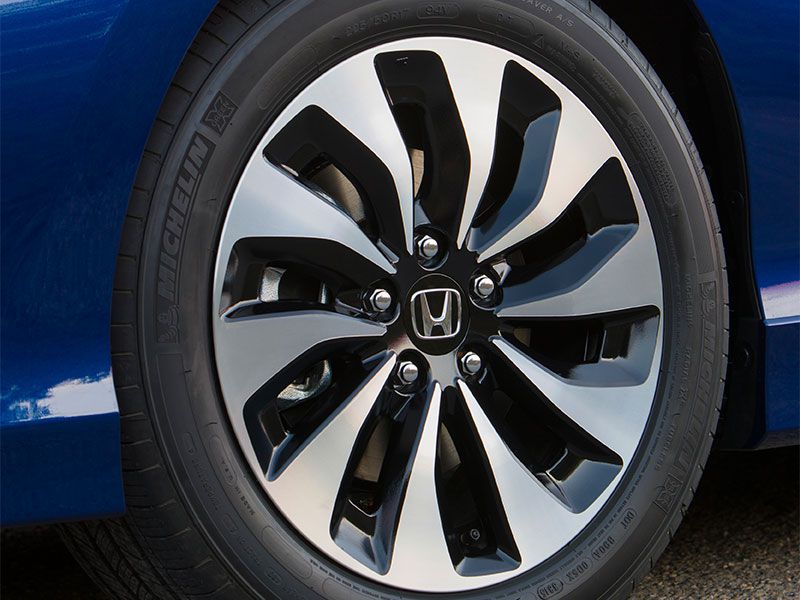
Photo by Honda
More Standard Safety Equipment—Including One of Our Faves
The 2016 Accord has a strong safety report card, with a perfect five stars from NHTSA and a Top Safety Pick+ award from the Insurance Institute for Highway Safety. The 2017 Hybrid has not been tested, but we would be surprised if its crash test results are any different. For 2017, all Accord Hybrids get Honda’s driver-aid suite, called Honda Sensing, as standard equipment. It includes adaptive cruise control (which detects cars ahead and slows to match their speed), lane-departure correction, and collision warning with automatic braking.
The Accord Hybrid also features one of our favorite safety gizmos, Honda’s Lane Watch system, which mounts a tiny camera in the right-side mirror. Hit the turn signal, and the camera presents a wide-angle view on the dash-mounted display screen, which shows more than than either the mirror or a glance over your shoulder, and with less distance for your eyes to travel. We cannot understate the brilliance of this system, and we can only hope that government regulators will take notice as they have with back-up cameras. We’d love to see it adapted to all cars, but for now, it’s a Honda exclusive.
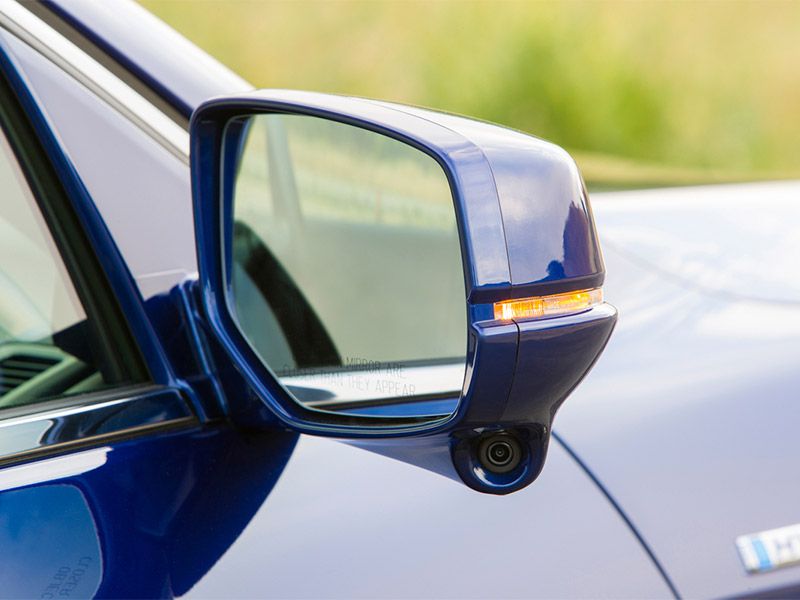
Photo by Honda
Bottom Line: The Best of Both Worlds
The 2017 Accord Hybrid is offered in three trim levels. The base car, priced at $30,440 (including an $835 destination fee) includes Honda Sensing, Lane Watch, dual-zone climate control, and a power seat, among other goodies. The $33,740 EX-L adds leather seats (heated in front), an auto-dimming rear view mirror, and the knob-less display stereo, while the $36,790 Touring model tops out the lineup with features including navigation, automatic rain-sensing wipers, and heated rear seats.
Overall, we think the Honda Accord Hybrid is an exceptionally smart buy. It’s at the top of the class for both passenger space and fuel economy, spanning the gap between dedicated hybrids and hybrid sedans and giving its owners the best of both worlds.
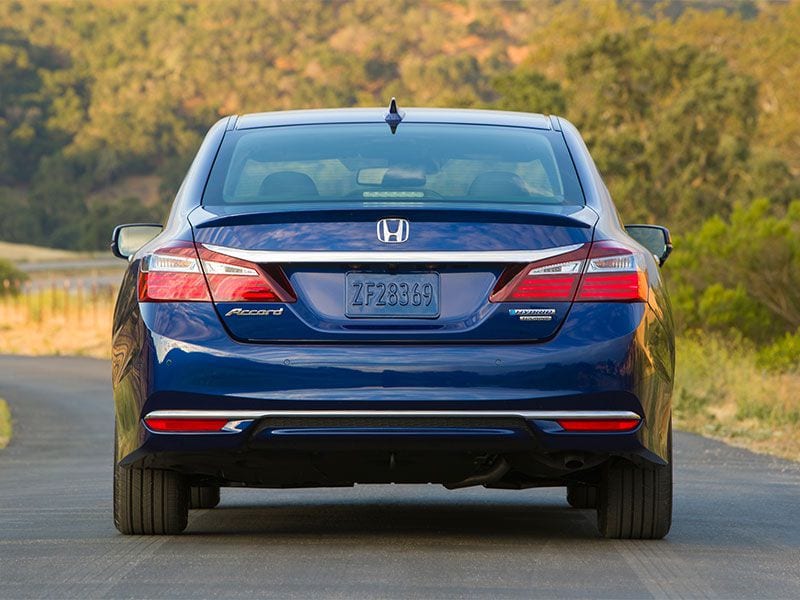
Photo by Honda